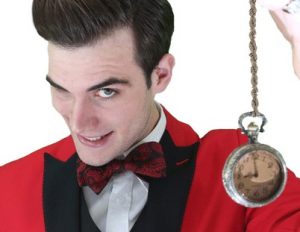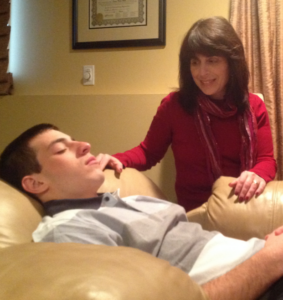
 Irritable bowel syndrome is a chronic condition that affects many people across the world. Due to symptoms such as abdominal pain, this disorder can have a big impact on life quality. New research, however, reveals that hypnotherapy can improve life for those with the condition.
Irritable bowel syndrome is a chronic condition that affects many people across the world. Due to symptoms such as abdominal pain, this disorder can have a big impact on life quality. New research, however, reveals that hypnotherapy can improve life for those with the condition.
Can hypnotherapy truly relieve IBS symptoms?
People with irritable bowel syndrome (IBS) can experience symptoms such as abdominal pain and abnormal bowel movements to various degrees of severity, and they can also face mental health problems, including anxiety and depression.
Some common approaches to managing IBS are by carefully controlling one’s diet, improving one’s lifestyle choices, and, if necessary, seeking mental health therapy.
In the past, some research has suggested that people with IBS may also benefit from hypnotherapy sessions. Now, specialists at the University Medical Center Utrecht and other institutions in the Netherlands have decided to delve deeper into the question of whether hypnotherapy can improve IBS symptoms — and if so, in what way. The researchers recently conducted a randomized controlled trial, the findings of which now appear in The Lancet Gastroenterology & Hepatology.
Improved symptom relief
The study assessed the efficacy of individual and group hypnotherapy in IBS. It is the largest study to date to look into this issue.
In the study, the researchers worked with 354 participants aged 18–65 with IBS.
The scientists randomly selected participants to take part in one of three interventions:
– individual 45 minute hypnotherapy sessions twice per week for 6 weeks (150 participants)
– group hypnotherapy sessions with the same timeframe (150 participants)
– dedicated educational supportive care sessions (54 participants)
For the delivery of the hypnotherapy sessions, the team recruited psychologists who had trained in hypnotherapy. During the sessions, the hypnotherapists applied techniques of positive visualization, providing suggestions about pain and discomfort management.
They also gave the participants CDs containing materials that would allow them to practice hypnosis techniques on their own for 15–20 minutes on a daily basis.
The researchers asked the participants to fill in questionnaires assessing various factors relevant to the study — including the severity of their IBS symptoms, their quality of life, how much they spent on healthcare, and how often they had to miss work due to the condition.
The assessments took place at baseline, at the 3-month mark, and at the 9-month mark. The team also evaluated to what extent participants experienced relief immediately after the intervention (at the 3-month mark) and then again 9 months later.
The scientists found that the people with IBS who had participated in hypnotherapy — whether individual or group-based — experienced the most satisfactory degree of symptom relief, compared with participants in the educational supportive care group.
Participants who underwent hypnotherapy were still enjoying the benefits 9 months after the treatment. However, the researchers claim that despite reporting satisfactory rates of symptom relief, the participants did not actually see a significant improvement in symptom severity as such.
“We do not know exactly how gut-directed hypnotherapy works,” says lead researcher Dr. Carla Flik, “but it may change patients’ mindset and internal coping mechanisms, enabling them to increase their control over autonomic body processes, such as how they process pain and modulate gut activity.”
 Group sessions just as promising
Group sessions just as promising
Other than symptom relief, the tested-for factors — including quality of life, psychological problems, healthcare costs, and work absence — remained roughly the same among all the participants following the interventions.
The researchers also admit that their study faced a few limitations. For example, some participants — 22 (15 percent) of those in the individual hypnotherapy group, another 22 (15 percent) of those in the group hypnotherapy sessions, and 11 (20 percent) of those in the educational supportive care group — dropped out of the study.
Also, a significant number of participants did not manage to fill in all the questionnaires, which, the researchers say, may have impacted the findings. However, the researchers note that the results they recorded in the recent study may, in fact, have been an underestimation, since the hypnotherapists did not have previous experience in treating people with IBS, specifically. Also, the participants only received six hypnotherapy sessions, which is only half the number of sessions that a person would normally expect to receive.
“Our study indicates that hypnotherapy could be considered as a treatment option for patients with IBS, irrespective of symptom severity and IBS sub-type. It is also promising to see that group hypnotherapy is as effective as individual sessions, which may mean that more people could be treated with it at lower cost, should it be confirmed in further studies.”
“What’s striking about these findings is the extent to which patients’ perception of their illness has an effect on their suffering, and that their perception of symptoms appears to be as important as actual symptom severity,” adds Dr. Flik.
By: Maria Cohut

Jordan overcame life-long anxiety with hypnotherapy. [info]
 According to thousands of years of tradition, Buddhists meditate to understand themselves and their connections to all beings. By doing so, they hope to be released from suffering and ultimately gain enlightenment.
According to thousands of years of tradition, Buddhists meditate to understand themselves and their connections to all beings. By doing so, they hope to be released from suffering and ultimately gain enlightenment.
In recent decades, researchers have been gaining insight into the benefits of practicing this ancient tradition. By studying more secular versions of mindfulness meditation, they’ve found that learning to pay attention to our current experiences and accept them without judgment might indeed help us to be happier.
Studies to date suggest that mindfulness affects many aspects of our psychological well-being—improving our mood, increasing positive emotions, and decreasing our anxiety, emotional reactivity, and job burnout.
Recently, researchers have been exploring this question—with some surprising results. While much of the early research on mindfulness relied on pilot studies with biased measures or limited groups of participants, more recent studies have been using less-biased physiological markers and randomly controlled experiments to get at the answer. Taken together, the studies suggest that mindfulness may impact our hearts, brains, immune systems, and more.
Though nothing suggests mindfulness is a standalone treatment for disease nor the most important ingredient for a healthy life, here are some of the ways that it appears to benefit us physically.
Mindfulness is good for our hearts
Heart disease is the leading killer in the United States, accounting for about 1 in 4 deaths every year. So, whatever decreases the risks or symptoms of heart disease would significantly impact society’s health. Mindfulness may help with that.
In one study, people with pre-hypertension were randomly assigned to augment their drug treatment with either a course in mindfulness meditation or a program that taught progressive muscle relaxation.
Those who learned mindfulness had significantly greater reductions in their systolic and diastolic blood pressure than those who learned progressive muscle relaxation, suggesting that mindfulness could help people  at risk for heart disease by bringing blood pressure down.
at risk for heart disease by bringing blood pressure down.
In another study, people with heart disease were randomly assigned to either an online program to help them practice meditation or to a wait list for the program while undergoing normal treatment for heart disease. Those who took the mindfulness program showed significant improvements on the six-minute walking test (a measure of cardiovascular capacity) and slower heart rates than those in the wait list group.
While one review of randomly controlled studies showed that mindfulness may have mixed effects on the physical symptoms of heart disease, a more recent review published by the American Heart Association concluded that, while research remains preliminary, there is enough evidence to suggest mindfulness as an adjunct treatment for coronary disease and its prevention.
Mindfulness may also be good for hearts that are already relatively healthy. Research suggests that meditating can increase respiratory sinus arrhythmia, the natural variations in heart rate that happen when we breathe that indicate better heart health and an increased chance of surviving a heart attack.
Mindfulness may decrease cognitive decline from aging or Alzheimer’s
People tend to lose some of their cognitive flexibility and short-term memory as they age. But mindfulness may be able to slow cognitive decline, even in people with Alzheimer’s disease. In a 2016 study, people with Alzheimer’s disease engaged in either mindfulness meditation, cognitive stimulation therapy, relaxation training, or no treatment, and were given cognitive tests over two years.
While cognitive stimulation and relaxation training seemed to be somewhat beneficial in comparison to no treatment, the mindfulness training group had much more robust improvements on cognitive scores than any other group.
Why might that be true? A 2017 study looking at brain function in healthy, older adults suggests meditation may increase attention. In this study, people 55 to 75 years old spent eight weeks practicing either focused breathing meditation or a control activity.
 Then, they were given the Stroop test—a test that measures attention and emotional control—while having their brains monitored by electroencephalography.
Then, they were given the Stroop test—a test that measures attention and emotional control—while having their brains monitored by electroencephalography.
Those undergoing breath training had significantly better attention on the Stroop test and more activation in an area of the brain associated with attention than those in the active control group.
While this research is preliminary, a systematic review of research to date suggests that mindfulness may mitigate cognitive decline, perhaps due to its effects on memory, attention, processing, and executive functioning.
Mindfulness may improve your immune response
When we encounter viruses and other disease-causing organisms, our bodies send out troops of immune cells that circulate in the blood. These cells, including pro- and anti-inflammatory proteins, neutrophils, T-cells,immunoglobulins, and natural killer cells, help us to fight disease and infection in various ways. Mindfulness, it turns out, may affect these disease-fighting cells.
In several studies, mindfulness meditation appeared to increase levels of T-cells or T-cell activity in patients with HIV or breast cancer. This suggests that mindfulness could play a role in fighting cancer and other diseases that call upon immune cells. Indeed, in people suffering from cancer, mindfulness appears to improve a variety of biomarkers that might indicate progression of the disease.
In another study, elderly participants were randomly assigned to an eight-week Mindfulness-Based Stress Reduction (MBSR) course or a moderate-intensity exercise program. At the end, participants who’d practiced mindfulness had higher levels of the protein interleukin-8 in their nasal secretions, suggesting improved immune function.
Another study found increases in interleukin-10 in colitis patients who took a mindfulness meditation course compared to a mind-body educational program, especially among patients whose colitis had flared up. Yet another study found that patients who had greater increases in mindfulness after an MBSR course also showed faster wound healing, a process regulated by the immune system.
Studies have found effects on markers of inflammation, too—like C-reactive protein, which in higher levels can harm physical health. Research shows that people with rheumatoid arthritis have reduced C-reactive protein levels after taking an MBSR course versus being on a waitlist for the course. Overall, these findings suggest that mindfulness meditation can have disease-fighting powers through our immune response.
Mindfulness may reduce cell aging
Cell aging occurs naturally as cells repeatedly divide over the lifespan and can also be increased by disease or stress. Proteins called telomeres, which are found at the end of chromosomes and serve to protect them from aging, seem to be impacted by mindfulness meditation.
 Studies suggest that long-time meditators may have greater telomere lengths. In one experimental study, researchers found that breast cancer survivors who went through MBSR preserved the length of their telomeres better than those who were on a wait list.
Studies suggest that long-time meditators may have greater telomere lengths. In one experimental study, researchers found that breast cancer survivors who went through MBSR preserved the length of their telomeres better than those who were on a wait list.
However, this study also found that general supportive therapies impacted telomere length; so, there may not be something special about MBSR that impacts cell aging. On the other hand, another study with breast cancer survivors found no differences in telomere length after taking an MBSR course; but they did find differences in telomere activity, which is also related to cell aging.
In fact, a 2018 review of research ties mindfulness training to increased telomere activity, suggesting it indirectly affects the integrity of the telomeres in our cells. Perhaps that’s why scientists are at least optimistic about the positive effects of meditation on aging.
Mindfulness may help reduce psychological pain
Of course, while the above physiological benefits of mindfulness are compelling, we needn’t forget that mindfulness also impacts our psychological well-being, which, in turn, affects physical health. In fact, it’s quite likely that these changes have synergistic effects on one another.
First of all, a great deal of research suggests that mindfulness can help healthy people reduce their stress. And thanks to Jon-Kabat Zinn’s pioneering MBSR program, there’s now a large body of research showing that mindfulness can help people cope with the pain, anxiety, depression, and stress that might accompany illness, especially chronic conditions.
For example, drug addictions, at heart, come about because of physiological cravings for a substance that relieves people temporarily from their psychological suffering. Mindfulness can be a useful adjunct to addiction treatment by helping people better understand and tolerate their cravings, potentially helping them to avoid relapse after they’ve been safely weaned off of drugs or alcohol. The same is true for people struggling with overeating.
Fascinating though it is, we shouldn’t overplay meditation’s effects on physical health at the expense of its importance to emotional health. In fact, it may be difficult to separate out the two, as a key impact of mindfulness is stress reduction, and psychological stress has been tied to heart health, immune response, and telomere length.
This idea is further supported by the fact that other stress-reducing therapies also seem to impact physical health, as well. Still, it’s encouraging to know that something that can be taught and practiced can have an impact on our overall health—not just mental but also physical—more than 2,000 years after it was developed. That’s reason enough to give mindfulness meditation a try.
By: Jill Suttie

 Hypnosis can reduce pain by up to 42% and may offer a genuine alternative to painkillers, according to UK researchers.
Hypnosis can reduce pain by up to 42% and may offer a genuine alternative to painkillers, according to UK researchers.
They said their findings suggest that hypnotic intervention could deliver “meaningful pain relief for most people” and, therefore, may be an “effective and safe alternative” to drug intervention.
The analysis, led by psychologist Dr Trevor Thompson from the University of Greenwich, found that hypnosis was more effective with people who are especially amenable to suggestion. “This is by far the largest review of its kind and presents very compelling evidence”.
However, it also found that those who were moderately suggestible – essentially most people – saw a 29% drop in pain after hypnosis.
Data was used from 85 studies across 14 countries, with a total of 3,632 people subjected to different forms of pain stimulation including extreme cold, heat,  pressure, exercise and even lasers.
pressure, exercise and even lasers.
People typically rated the pain they felt as 5.5 on a scale of zero to 10, according to the study published in the journal of Neuroscience and Bio-behavioral Reviews.
According to the researchers, a five level of pain would significantly disrupt daily lives and have most people using medication.
Dr Thompson said: “This is by far the largest review of its kind, examining the effects of hypnosis in over 3,500 people, and presents very compelling evidence.
“About 15% of the population are highly receptive to hypnosis, and those people saw just over a 40% drop in pain,” he noted.
“Based on these findings, most people would experience around a 30% drop in pain or more, which is generally considered to be clinically meaningful pain relief,” he said.
Dr Thompson highlighted that the misuse of prescription painkillers such as codeine and fentanyl had increased massively over recent years and was a crisis in some countries, most notably the US.
 “Our findings suggest hypnosis could be a safe and effective alternative,” he said. “It can be administered quickly, cheaply and easily at home with a 20-minute audio recording.”
“Our findings suggest hypnosis could be a safe and effective alternative,” he said. “It can be administered quickly, cheaply and easily at home with a 20-minute audio recording.”
He added: “The next step is to extensively test hypnosis on people with chronic pain, such as back conditions, which people live with every day.
“Available data on this are not of a high enough quality or quantity,” he said. “We need to go and try this with people in their day-to-day lives.”
By: Nursing Times News Desk

 Last summer, at age 14, Sue Jones suffered from stabbing pains in her abdomen that got so intense, “I couldn’t walk.”
Last summer, at age 14, Sue Jones suffered from stabbing pains in her abdomen that got so intense, “I couldn’t walk.”
She spent three weeks in a wheelchair while doctors ruled out everything from digestive problems to appendicitis. Finally, after a four-night stay at BC Children’s Hospital in Vancouver, she got a diagnosis: acute anxiety.
An honor student, Sue is thin, dark-haired and lily pale. (Her parents requested a pseudonym to protect her privacy.) When a doctor recommended hypnosis, she balked at first. “I thought of it as black magic, like witchcraft,” she says. But neither breathing exercises, nor anti-depressants, had taken away the pain.
So, in early September, she visited Dr. Leora Kuttner, a pediatric psychologist who specializes in clinical hypnosis, a technique for leveraging the brain’s healing abilities during a trance state.
Kuttner’s office has a rumpus-room feel, with toys, plants and colorful pictures scattered about. Settling into a plump beige armchair by the window, Sue breathed slowly as the psychologist asked her to “go to a quiet place.” She chose a beach. Then, in a soft, soothing voice, Kuttner suggested that she imagine a “protection skirt” that could shield her from stomach pain.
Sue pictured herself covered in “a golden, shimmery, transparent cocoon, floating up in the air above this beach.” For a few moments, she felt as though she had left the room. When Kuttner called her out of her reverie, “I was surprised where I was.” Another surprise: the pain was gone.
Sue keeps a recording of her “protection skirt” hypnosis handy on her phone – all 5 minutes, 56 seconds of it. She is still learning to keep anxiety at bay, but if the abdominal pain ever comes back, she says, “I know how to deal with it.”
Hypnosis isn’t just for hucksters and Hollywood villains any more. Neuroscience studies have shown that this mind-body therapy affects the brain in extraordinary ways. Clinical trials have demonstrated its effectiveness in treating anxiety, phobias, skin rashes, irritable-bowel syndrome and acute and chronic pain.
In France and Belgium, anesthesiologists are offering hypnosis combined with local anesthetic as an alternative to general anesthesia in surgery. In North America, medical centers such as the Mayo Clinic have added hypnosis to their pain-management tools.
Hypnosis doesn’t work for everyone, notes Dr. Amir Raz, Canada Research Chair in the cognitive neuroscience of attention at McGill University and the Jewish General Hospital in Montreal. But “in my opinion, it’s completely underused.”
That may be changing, especially in pediatrics. Over the past four years, Kuttner has been invited to teach hypnosis at the Mayo Clinic, Alberta Children’s Hospital in Calgary and the Hospital for Sick Children in Toronto. Kuttner, who developed her techniques more than three decades ago, says she’s “thrilled” by the uptake.
As with mindfulness meditation, hypnosis harnesses the brain’s natural abilities to regulate the body and control the random thoughts that ricochet through our minds, says Dr. David Patterson, a University of Washington psychologist who has studied hypnosis since the 1980s, in a series of clinical trials financed by the U.S. National Institutes of Health.
But, he adds, meditation can take weeks or months of practice before it helps patients dial down pain. With hypnosis, “the relief is just a lot quicker and more dramatic.”
Hypnosis reduces our awareness of what’s going on around us, even as it increases our attention and openness to new ideas. The brain’s  command center lets its guard down, allowing the therapist’s suggestions to embed themselves into the parts of our grey matter that regulate our thoughts, perceptions and physiology, Patterson says. “It’s as if you’re talking directly to the brain.”
command center lets its guard down, allowing the therapist’s suggestions to embed themselves into the parts of our grey matter that regulate our thoughts, perceptions and physiology, Patterson says. “It’s as if you’re talking directly to the brain.”
At Legacy Oregon Burn Center in Portland, Ore., Dr. Emily Ogden, a psychologist, uses hypnosis to help patients cope with the most excruciating injuries you can have.
In the facility’s bedroom-sized intensive-care units, machinery for monitoring vital signs beeps nonstop as nurses and doctors cut away layers of clothing and scorched flesh. The air is putrid-sweet, the smell of open wounds.
Often, the pain of the burn itself pales next to the agony of having dead tissue removed in a process called debridement, or a patch of healthy skin shaved and grafted onto a wound. Then there are the dressing changes. Every day or so, nurses replace fluid-soaked gauze to prevent a burn victim’s greatest threat: infection. The sudden gust of cold air on exposed wounds can be torturous, even with painkillers.
Burn patients tend to be open to hypnosis, Ogden says, but they often add something such as, “I’m not going to squawk like a chicken, am I?”
After reassuring them that no, she won’t make them cluck, Ogden stands by the bedside and asks the patient to imagine stepping down a flight of stairs as she counts backward from 20. Once the patient is deeply relaxed, she gives a series of hypnotic “suggestions,” or instructions for the brain.
For example, “When a nurse touches you on the shoulder, you will return to the feeling of relaxation you have now,” she might say. “During the procedure, you will have no feelings other than comfort and relaxation. Later, you’ll be surprised at how easily it goes for you.”
As simple as it sounds, the technique usually works, says Ogden, who began offering hypnosis six months ago. “It has proven to be such a beneficial and effective intervention.”
Hypnosis stimulates specific brain activity, according to a 2016 study from Stanford University. Researchers found three brain changes in adults who scored high in susceptibility to hypnosis and these changes occurred only while they were hypnotized.
Using a brain-imaging technique called fMRI, researchers found decreased activity in the brain’s salience network, the inner “air-traffic controller” that processes stimuli and preps us for action.
Secondly, they saw greater connectivity between the brain’s executive-control network and the insula, a grape-sized region deeper in the brain that helps us “control what’s going on in the body, and process pain,” the study’s co-author, psychiatrist Dr. David Spiegel, says.
Finally, the researchers observed reduced connections between the executive-control center and the “default-mode” network, involved in self-reflection. This could lead to a disconnect between a person’s actions and their awareness of their actions, Spiegel says.
He describes hypnosis as a “very powerful means of changing the way we use our minds to control perception, and our bodies.” If more practitioners had training to use it, hypnosis could make “a huge difference” in the opioid epidemic, he adds.
In a previous study, published in The Lancet, Spiegel and colleagues instructed patients in self-hypnosis techniques before they underwent vascular or kidney procedures.
Compared with patients receiving standard care, the hypnosis group used significantly less pain medication (fentanyl and midazolam). Spiegel’s team is now testing the same approach in knee- and hip-surgery patients.
He notes that the risk of addiction increases when people are on opioid painkillers for more than three days. If patients can get through the post-surgical period faster, “you can prevent them from getting hooked.”
 But hypnosis has an image problem. Unlike mindfulness, it lacks Zen-master cachet. Doctors and patients have trouble forgetting the dangling pocket watches of stage hypnosis, or the bad guys who put sleeper agents under “mind control” in movies such as The Manchurian Candidate.
But hypnosis has an image problem. Unlike mindfulness, it lacks Zen-master cachet. Doctors and patients have trouble forgetting the dangling pocket watches of stage hypnosis, or the bad guys who put sleeper agents under “mind control” in movies such as The Manchurian Candidate.
Despite solid evidence from clinical trials, the medical field’s approach to hypnosis has been “extremely careful and conservative,” Raz says.
And let’s face it: For every credible scientist studying hypnosis, there are hundreds of charlatans touting self-hypnosis CDs or sessions on Skype as a miracle cure for everything from obesity to cancer. In the land of psychics and crystal magic, anyone can become a “certified hypnotherapist” in a month or less. Rampant quackery “gives us a bad name,” Patterson says.
Adults tend to insist they are impervious to hypnosis, even if they’ve never tried it, Raz says. They think of it as “feeble-mindedness, or the ability to be manipulated.”
But in fact, people who respond to hypnosis may have better co-ordination between brain areas that “integrate attention, emotion, action and intention,” according to a 2012 study published in the Archives of General Psychiatry.
About 10 to 15 percent of adults are “highly hypnotizable,” meaning they can easily slip into a trance and act on hypnotic suggestions. The same percentage of adults do not respond to hypnosis at all, while the rest are somewhere in between. The trait may be genetic, researchers say. But imagination also plays a role.
Responsiveness to hypnosis reaches its peak between the ages of 8 and 12, says Kuttner, who began using hypnosis in the mid-1980s to help children cope with pain in the oncology ward at BC Children’s Hospital.
She documented her techniques in No Tears, No Fears, a short film featuring eight kids with cancer, aged 3 to 12. Guided by Kuttner, the children went through procedures such as spinal taps with only local anesthetic at the needle site. (At the time, general anesthesia in children was reserved for special circumstances, such as major surgery.)
Most children can easily imagine an invisible “magic glove” that keeps needles from hurting, or a fantasy world free of pain, Kuttner says. Concentrating on these beliefs can have analgesic effects. With a fond smile, she recalls a child with leukemia who spent her treatments in an imaginary land of candy.
A more recent patient, 17-year-old Isabella Hay, says working with Kuttner helped her overcome muscle twitches and symptoms of obsessive-compulsive disorder. Starting at the age of 4, Isabella learned to visualize entering a room and turning off switches that controlled her nervous ticks.
When Isabella received a diagnosis of OCD at the age of 13, Kuttner taught her how to focus on her breathing and picture herself in calm place, using a form of self-hypnosis. The technique has given her control over compulsive behaviors, such as a need to touch a rock a certain number of times, Isabella says.
She used to feel panicky at the idea of sleeping away from home. Now, she is graduating from high school with acceptance letters from both the University of British Columbia and Queen’s University. Knowing that the brain is strong enough to “transport you from the thoughts,” Isabella says, “I feel more secure and confident, and less vulnerable in my own head.”
Hypnosis techniques are relatively easy for health-care professionals to learn, Kuttner says. But like other specialists interviewed for this article, she cautions patients against seeking hypnosis from someone with no medical training. “Things can go haywire.”
A lay hypnotist could fail to recognize the signs of psychosis, or encourage someone to regress to an earlier life stage filled with traumatic memories, “and they won’t have a clue how to help the person.”
Kuttner recalls treating a patient who had gone to a lay hypnotist for headache relief but came away weeping and confused. Hypnosis needs to be in the hands of “someone who respects it, and knows what they are doing,” she says. “This is powerful stuff.”
In hypnosis circles, the word “powerful” comes up a lot. But it’s hardly an overstatement when you consider the work of Dr. Marie-Elisabeth Faymonville, director of the pain clinic and palliative care at the University Hospital of Liège, Belgium.
Hypnosis allows patients to avoid general anesthesia in surgeries ranging from mastectomies to heart-valve replacements, Faymonville says.
Since 1992, she has treated more than 9,500 surgery patients with “hypno-sedation,” combining hypnosis with small amounts of local  anesthesia. Of those patients, just 18 had to switch to general anesthesia. “It’s really rare,” she says, in German-accented English.
anesthesia. Of those patients, just 18 had to switch to general anesthesia. “It’s really rare,” she says, in German-accented English.
The method appeals to patients who want to be “aware during surgery, but comfortable.” Patients do not get a dry run. Instead, Faymonville assesses their level of motivation and confidence in the surgical team, and their ability to co-operate.
Hypno-sedation works because the patient wants it to work, she says: It’s the opposite of “mind control.” The anesthesiologist’s job is to use hypnotic techniques and communicate with the patient, but the patient must collaborate, “so he puts himself in the hypnotic state.”
She emphasizes that unlike the cross-section of patients you might find in the average hospital, her patients are “highly motivated” to stay conscious during surgery. But in general, she adds, doctors tend to underestimate the resources patients can access with their own minds. “Hypnosis is a talent, a gift from nature.”
THE GIFT OF HYPNOSIS
The ability to be hypnotized is a talent, like an ear for music, researchers say. The easiest way to know if you have it is to give it a try. So, I ask Dr. Lance Rucker, president of the Canadian Society of Clinical Hypnosis, if he’ll hypnotize me.
A dentist by training, Rucker teaches hypnosis to third-year dentistry students at the University of British Columbia, where it’s part of the required curriculum.
Dentists need to learn the basics of hypnosis to “avoid abusing the trance state,” he says. People drift in and out of light trances throughout the day, whether they’re on “autopilot” for the daily commute, or so engrossed in an X-Men flick that they forget it’s a movie.
Dental patients – triggered by memories of needles, drills and frozen-gums past – are often in a daze even before they lie on the chair. When patients are in this vulnerable state, a dentist’s soothing words (“let’s make sure you’re comfortable”) can help make it so. On the flip side, stock phrases such as, “this might hurt a little,” may intensify pain and fear, he says.
Rucker emphasizes that reputable practitioners will not use hypnosis for purposes outside their medical specialty. He asks if I have a dental issue I’d like to resolve. An overactive gag reflex, perhaps? Or a fear of dental fillings?
I am definitely a grinder. That may not be easily fixed, depending on the root cause, he replies. But he’s willing to give it a go.
We sit in the front seats of his scarlet Acura, parked outside a cluster of big-box stores near his home in Burnaby, B.C. The windows are closed to shut out the rumble of traffic and the air is warm and stuffy. I am drowsy already.
In a soft, calm voice, Rucker asks me to take myself to “an internal space, a creative space.” As I relax, he says, my inner awareness can let me know “what it’s all about, and has been all about – the clenching, the grinding.”
A symbol or realization may come to mind. He pauses for a few moments. Then he suggests that I ask my inner self whether it can let the grinding go, “or whether there is some part of you that may wish to hold on to it.”
As his voice meanders, I have a clear picture of a big black dog with massive metal jaws. Could my clenching be a hard-wired defense mechanism? It’s an obvious symbol. But as it turns out, my inner guard dog refuses to back down easily. Later that day, my jaw feels as tight as ever.
A life-long grinding habit could be a problem that a single session in a parked car cannot solve. I might give hypnosis another try. But maybe I just don’t have the gift.
By: Adrianna Barton

 Melissa Cipriana had no explanation left for why she couldn’t lose weight. She avoided processed foods, “white” carbohydrates and soda. She attended SoulCycle classes religiously. And she certainly had discipline: She had already lost – and kept off for years – 50 pounds through a medically supervised hCG diet, which involves eating less than 800 calories a day and receiving injections of a hormone marketed to suppress appetite.
Melissa Cipriana had no explanation left for why she couldn’t lose weight. She avoided processed foods, “white” carbohydrates and soda. She attended SoulCycle classes religiously. And she certainly had discipline: She had already lost – and kept off for years – 50 pounds through a medically supervised hCG diet, which involves eating less than 800 calories a day and receiving injections of a hormone marketed to suppress appetite.
And yet, the last 20 or 30 pounds simply wouldn’t come off. Only one possibility remained: “I knew it had everything to do with my thoughts,” says Cipriani, a 38-year-old resort CEO who splits her time between Denver and Granby, Colorado.
So Cipriani booked a session with a local hypnotherapist, whom she’d heard about through a Facebook friend and connected with via phone. “We didn’t talk about food, we didn’t talk about diet or calories in versus calories out … she was more like changing my mindset,” recalls Cipriani, who was living in New York City at the time, of her first session.
More specifically, at some sessions, Cipriani was guided into a state of deep relaxation. There, she was encouraged to discover and confront some of the mental and emotional barriers like overthinking and over-researching diet choices that had been preventing her from reaching her goals. She later integrated phrases like “I easily and effortlessly lose weight” into her psyche.
Six months later, she’d lost at least 10 pounds.”Once I broke down the barrier of ‘overthinking it’ and just accepted that I easily and effortlessly lose weight, it just came off – I knew the choices I was making were the right choices for me.” says Cipriani, who focused on eating whole foods like lean proteins, healthy fats and whole grains, and worked with a personal trainer. She eventually lost the rest of the weight and has maintained it to this day, about four years later.
Cipriani also credits hypnotherapy, which she continues to use in various forms including apps and self-hypnosis, with allowing her to meet her now-husband and cope with work stress. “I really do obviously believe [in hypnotherapy] … I have a fuller life because of it,” Cipriani says.
How Does Hypnosis Work?
Despite lingering misperceptions, hypnosis actually looks and acts a lot more like mindfulness meditation or cognitive behavioral therapy than mind control or a magic show. Like meditation, it involves getting into a  very relaxed, focused state; like CBT, it involves noticing and challenging negative thought patterns.
very relaxed, focused state; like CBT, it involves noticing and challenging negative thought patterns.
“It’s not like you’re going to get hypnotized and you’re not going to know who you are and you’re going to be made to do something by someone,” says Eric Spiegel, a clinical psychologist in the greater Philadelphia area who serves as president of the American Society of Clinical Hypnosis. “I’m going to offer you ideas and choices and let you lead the way, but I’ll kind of help you figure out the path.”
But one key characteristic that can make hypnosis work more swiftly and powerfully than more widely accepted practices is also what keeps it somewhat shrouded in mystery: It works on the subconscious level, and researchers don’t know exactly how, says David Godot, a clinical psychologist in Long Beach, California, who serves as secretary of the Society of Psychological Hypnosis, a division of the American Psychological Association.
“With hypnosis, you get into a particular state of mind where there’s a closeness between the contents of the conscious and unconscious awareness,” he explains. When you’re in it then, your conscious mind or a practitioner can offer suggestions to your subconscious mind. For example, Grace Smith, Cipriani’s Vero Beach, Florida-based hypnotherapist, might have clients looking to break unhealthy eating habits repeat, “Food is fuel. I only put the highest quality food into my body.” Occasionally, she uses “aversion therapy,” too, in order to create a negative association with a food or drink that has a deep-seeded positive association – cupcakes that used to be tied to comfort are now tied to disgust.
The idea is that by feeding these thoughts to your subconscious, you can change deeply rooted behaviors without so much conscious effort, just like you may awake from a dream with a solution to a complicated problem, or may experience a lightbulb moment while zoning out in the shower. “There’s this creative part of your mind that’s working all the time while you’re not aware of anything else,” Godot says. Through hypnosis, he adds, “that creative process can be directed to work on this particular problem.”
Proceed With Cautious Optimism
There’s some research on hypnosis for weight loss, and the results are moderately promising. One 2005 review in the International Journal of Obesity found that, taken together, the stronger studies on hypnosis for weight loss have shown that hypnotherapy leads to more dropped pounds than either cognitive behavioral therapy or dietary advice alone.
Another 2009 study concluded that hypnosis was among the only three evidence-based complementary treatments for obesity, but that if used at all, it should be used alongside tried-and-true calorie restriction and exercise. As the American Society of Clinical Hypnosis puts it, hypnosis “is of major benefit to some patients with some problems, and it is helpful with many other patients, but it can fail, just like any other clinical method.”
Whether it works for you may come down to your personality and fit with a provider, among other individual characteristics. Specifically, certain people are highly “hypnotizable” (if you easily get lost in thought or are artistically inclined, you may be one of them), and some people are especially vulnerable to suggestion under hypnosis (including people who are deemed “gullible” in conscious life), Spiegel explains. The higher you are on these traits, the faster and more effectively hypnosis will likely work, though people lower on the scales can benefit too.
You also have to truly want a particular outcome for hypnosis to work, Smith says. For example, if you say you want to quit your nighttime ice cream habit but actually love the taste and find the ritual soothing, you won’t have as much luck as someone who hates feeling compelled to eat ice cream nightly – even though he no longer enjoys it. “You need a goal [because] how much you want the result is the No. 1 thing that will dictate the results you get,” says Smith, author of the new book, “Close Your Eyes, Get Free,” which aims to make hypnosis mainstream by teaching people how to do it to themselves.
 Even if you do have a natural affinity for hypnosis and a genuine goal, finding an appropriately trained therapist who’s right for you can be complicated since there’s no single credentialing organization, state licensing rules differ (when they exist at all) and hypnotherapists may include physicians, nurses, dentists, social workers, psychologists and regular Joes. “All the time I see people who will say things like, ‘I’m a certified hypnotherapist,'” Spiegel says. “The question is, ‘OK, what are you certified in and what is your professional degree and do you have a license?'”
Even if you do have a natural affinity for hypnosis and a genuine goal, finding an appropriately trained therapist who’s right for you can be complicated since there’s no single credentialing organization, state licensing rules differ (when they exist at all) and hypnotherapists may include physicians, nurses, dentists, social workers, psychologists and regular Joes. “All the time I see people who will say things like, ‘I’m a certified hypnotherapist,'” Spiegel says. “The question is, ‘OK, what are you certified in and what is your professional degree and do you have a license?'”
Asking those questions – in addition to gauging your rapport with the potential therapist and inquiring about the hours they spent in training and in practice – is important because hypnotherapy can uncover forgotten traumatic experiences. Under the care of an unprepared provider, that experience can feel traumatic all over again rather than empowering. Godot’s rule of thumb for hypnotherapists? “Don’t use hypnosis to treat anything you wouldn’t otherwise be qualified to treat,” he says.
Good training is also important because hypnosis isn’t just about reading from a script, it’s about learning how language, pacing and tone of voice lead to the desired outcome, Spiegel says. Hypnotic suggestions or affirmations need to be positive – “I choose healthy portion sizes” rather than “I don’t overeat” – since the unconscious mind doesn’t “hear” the negative, and instead reinforces “I overeat,” says Smith, who is not a health care professional but became certified by several organizations including the International Hypnosis Federation before launching her own hypnotherapy training school.
Finally, the therapist’s philosophy matters since professionals differ, for instance, on whether it’s harmful or hurtful to instill beliefs that foods are “good” or “bad.” While Smith finds those types of mantras help break associations that are no longer helpful, other hypnotherapists like those at NY Health Hypnosis and Integrative Therapy in Manhattan do the opposite for people trying to lose weight or overcome eating disorders. “The goal is not just to end the addiction, but also to stop viewing food in terms of good and bad so that a person gets out of the cycle of overindulging and self-blame,” the therapists say on their website. Here too, knowing what resonates with you matters.
All caveats considered, health professionals say hypnosis can be powerful for life-long behavior change and no more risky than meditation or yoga. “Hypnosis is not some magical practice that is to be feared,” Godot says. “It’s just a set of techniques and tools to get closer to understanding … what’s happening in the mind.”
By: Anna Medaris Miller, Staff Writer

 Irritable bowel syndrome is a chronic condition that affects many people across the world. Due to symptoms such as abdominal pain, this disorder can have a big impact on life quality. New research, however, reveals that hypnotherapy can improve life for those with the condition.
Irritable bowel syndrome is a chronic condition that affects many people across the world. Due to symptoms such as abdominal pain, this disorder can have a big impact on life quality. New research, however, reveals that hypnotherapy can improve life for those with the condition.
 Group sessions just as promising
Group sessions just as promising
 According to thousands of years of tradition, Buddhists meditate to understand themselves and their connections to all beings. By doing so, they hope to be released from suffering and ultimately gain enlightenment.
According to thousands of years of tradition, Buddhists meditate to understand themselves and their connections to all beings. By doing so, they hope to be released from suffering and ultimately gain enlightenment. at risk for heart disease by bringing blood pressure down.
at risk for heart disease by bringing blood pressure down. Then, they were given the Stroop test—a test that measures attention and emotional control—while having their brains monitored by electroencephalography.
Then, they were given the Stroop test—a test that measures attention and emotional control—while having their brains monitored by electroencephalography. Studies suggest that long-time meditators may have greater telomere lengths. In one experimental study, researchers found that breast cancer survivors who went through MBSR preserved the length of their telomeres better than those who were on a wait list.
Studies suggest that long-time meditators may have greater telomere lengths. In one experimental study, researchers found that breast cancer survivors who went through MBSR preserved the length of their telomeres better than those who were on a wait list.
 Hypnosis can reduce pain by up to 42% and may offer a genuine alternative to painkillers, according to UK researchers.
Hypnosis can reduce pain by up to 42% and may offer a genuine alternative to painkillers, according to UK researchers. pressure, exercise and even lasers.
pressure, exercise and even lasers. “Our findings suggest hypnosis could be a safe and effective alternative,” he said. “It can be administered quickly, cheaply and easily at home with a 20-minute audio recording.”
“Our findings suggest hypnosis could be a safe and effective alternative,” he said. “It can be administered quickly, cheaply and easily at home with a 20-minute audio recording.”
 Last summer, at age 14, Sue Jones suffered from stabbing pains in her abdomen that got so intense, “I couldn’t walk.”
Last summer, at age 14, Sue Jones suffered from stabbing pains in her abdomen that got so intense, “I couldn’t walk.” command center lets its guard down, allowing the therapist’s suggestions to embed themselves into the parts of our grey matter that regulate our thoughts, perceptions and physiology, Patterson says. “It’s as if you’re talking directly to the brain.”
command center lets its guard down, allowing the therapist’s suggestions to embed themselves into the parts of our grey matter that regulate our thoughts, perceptions and physiology, Patterson says. “It’s as if you’re talking directly to the brain.” But hypnosis has an image problem. Unlike mindfulness, it lacks Zen-master cachet. Doctors and patients have trouble forgetting the dangling pocket watches of stage hypnosis, or the bad guys who put sleeper agents under “mind control” in movies such as The Manchurian Candidate.
But hypnosis has an image problem. Unlike mindfulness, it lacks Zen-master cachet. Doctors and patients have trouble forgetting the dangling pocket watches of stage hypnosis, or the bad guys who put sleeper agents under “mind control” in movies such as The Manchurian Candidate. anesthesia. Of those patients, just 18 had to switch to general anesthesia. “It’s really rare,” she says, in German-accented English.
anesthesia. Of those patients, just 18 had to switch to general anesthesia. “It’s really rare,” she says, in German-accented English.
 Melissa Cipriana had no explanation left for why she couldn’t lose weight. She avoided processed foods, “white” carbohydrates and soda. She attended SoulCycle classes religiously. And she certainly had discipline: She had already lost – and kept off for years – 50 pounds through a medically supervised hCG diet, which involves eating less than 800 calories a day and receiving injections of a hormone marketed to suppress appetite.
Melissa Cipriana had no explanation left for why she couldn’t lose weight. She avoided processed foods, “white” carbohydrates and soda. She attended SoulCycle classes religiously. And she certainly had discipline: She had already lost – and kept off for years – 50 pounds through a medically supervised hCG diet, which involves eating less than 800 calories a day and receiving injections of a hormone marketed to suppress appetite. very relaxed, focused state; like CBT, it involves noticing and challenging negative thought patterns.
very relaxed, focused state; like CBT, it involves noticing and challenging negative thought patterns. Even if you do have a natural affinity for hypnosis and a genuine goal, finding an appropriately trained therapist who’s right for you can be complicated since there’s no single credentialing organization, state licensing rules differ (when they exist at all) and hypnotherapists may include physicians, nurses, dentists, social workers, psychologists and regular Joes. “All the time I see people who will say things like, ‘I’m a certified hypnotherapist,'” Spiegel says. “The question is, ‘OK, what are you certified in and what is your professional degree and do you have a license?'”
Even if you do have a natural affinity for hypnosis and a genuine goal, finding an appropriately trained therapist who’s right for you can be complicated since there’s no single credentialing organization, state licensing rules differ (when they exist at all) and hypnotherapists may include physicians, nurses, dentists, social workers, psychologists and regular Joes. “All the time I see people who will say things like, ‘I’m a certified hypnotherapist,'” Spiegel says. “The question is, ‘OK, what are you certified in and what is your professional degree and do you have a license?'”







